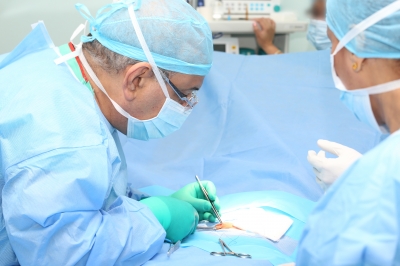The original technique used across the world, including the UK until the founding of The British Hernia Centre, was to admit the patient to hospital for a few days and, under general anaesthesia, the surgeon would push back the bulge of peritoneum through the opening and then close the defect by stitching one side firmly to the other.
for a few days and, under general anaesthesia, the surgeon would push back the bulge of peritoneum through the opening and then close the defect by stitching one side firmly to the other.
Because the patient depends upon this stitching for the rest of his life to hold the abdominal wall closed, the surgeon would normally have to place several stitches under a degree of tension in the deep tissue, repeating the process until he is satisfied that the join will hold.
Unfortunately this stitching distorts sensitive tissue. This will cause tension and subsequent pain with all movements (including coughing and sneezing).
The patient can expect to feel the results of the stitching long after he leaves hospital. He is therefore restricted in physical activity for some weeks.
A further problem of this technique of hernia repair is that a significant number of cases (estimated at 10% of all cases) will recur by virtue of the internal scar tissue becoming pulled out at some time in the patient’s life. The repair of this recurrent hernia is therefore a larger operation than the first and the results proportionately more uncomfortable.
In order to reduce the tension of the stitching, surgeons developed methods of stitching the tissue in layers, one above the other. This technique reduced a little of the pressure, but resulted in more stitching through the patient’s tissue.
Later techniques involve placing or stitching a patch over the hernia, stapling or otherwise closing the defect.
However the stitching is done, tissue distortion is inevitable with consequent pain for the patient.
Next: Keyhole Surgery
